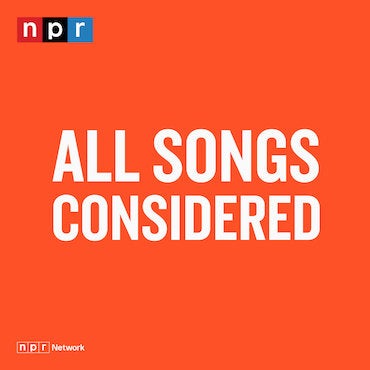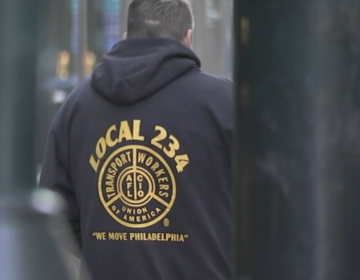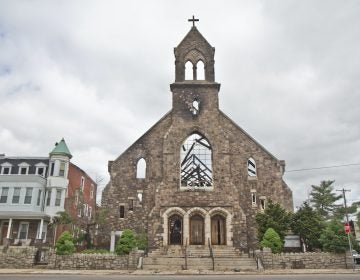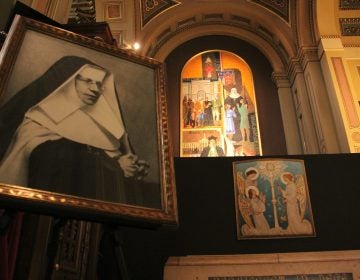Organizations with deep community roots on mission to strengthen Philadelphia
Put together the needs and the assets on either side of the walls of the sacred properties, and you see a whole new necessity – and possibility.
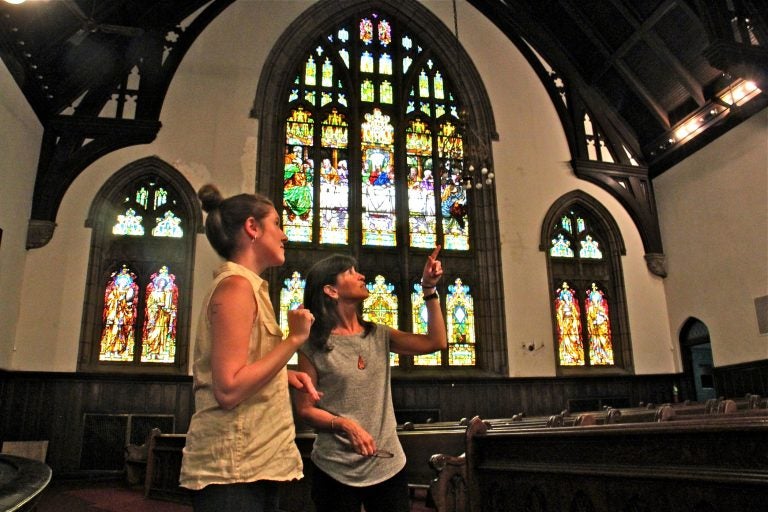
Heidi Segall Levi of Community Design Collaborative (right) and Rachel Hildebrandt of Partners for Sacred Places talk about potential uses for the main sanctuary in Wharton-Wesley United Methodist Church. (Emma Lee/WHYY)
What a difference a good conversation can make. Sometimes all you need is the right prompt.
It was an inspired prompt from Cara Ferrentino at the William Penn Foundation that led to the conversation between Partners for Sacred Places and the Community Design Collaborative. That’s the chat that led, in turn, to Infill Philadelphia 2018: Sacred Places/Civic Spaces.
As with many good conversations, it wasn’t the first between the two groups; Partners and the Collaborative already had a solid track record of collaboration and complementarity. It was that track record that simply invited the natural next step of their work together.
Most older neighborhoods in a historic cities have, say, a library or school. But as you wander Philly neighborhoods, you’ll also find an abundance of sacred buildings. Often beautiful, centrally located, and designed for communal use, many of those beautiful walls nonetheless housed empty space that was underfunded, underutilized, and in need of repair.
Meanwhile, beyond those sacred walls, neighborhoods have been changing.
While the things communities focus on have altered somewhat over the same years that religious attendance and financial support were shifting, the need for in-person, on-site space for all kinds of activities remains pretty constant for building communities. Sacred places are already serving civic needs: Some 90 percent of those who benefit from the programs run in sacred spaces aren’t members at all, in physical spaces that may not be well set up for those new functions.
Put together the needs and the assets on either side of the walls of the sacred properties, and you see a whole new necessity – and possibility – for conversation about activating more civic space hand-in-hand with the
congregation. And that’s what Partners and the Collaborative are doing.
Opportunity for intention, time, and support
In short, Sacred Places/Civic Spaces is another step in using existing structures – both buildings and networks – to strengthen Philly neighborhoods. The project takes three sites around Philly and groups each one with a design firm and a social-service organization. Each team will work for six months on a model for civic space within the specs of what that particular building and neighborhood are like. Rather than simply trying to avoid a problem or react with a short-term fix – as so many faith communities have to do – it’s the chance to have the intention, time, and support to think about solid steps with longer-term potential.
Of particular interest to me was the deeper perspective that both organizations brought to working with older urban spaces.
They were both founded around the same time – Partners in 1989 and the Collaborative in 1991, presumably in response, in different ways, to similar trends. Since 2005, the Collaborative has spearheaded the Infill Philadelphia series, bringing urban players into new partnerships in strategic ways, in order to create shareable models and help organizations in fundraising.
Since its inception, Partners has focused on resourcing congregations to think creatively about how their space is used. And both groups have wisdom that comes from seeing how the questions and possibilities have grown over time.
Beth Miller, executive director of Community Design Collaborative, had a take that we all should have in our work lives: she says they’re always looking for partners who bring skills that complement what the Collaborative does.
“Partners [for Sacred Places] is that now,” she says. “We have the design lens, but it’s not the only lens. That’s what we’re trying to elevate in this conversation. We don’t know the answers yet, but we hope to get the possibilities that public, private, civic sectors can take hold of.”
Robert Jaeger, who in addition to being the president of Partners for Sacred Places was also co-founder back in 1989, says that a project like the one with the Collaborative would not have been thinkable back in the late ‘80s.
“We were interested in opening [sacred] buildings, rethinking how they were used, and helping smaller churches sustain themselves,” he says, “as well as building bridges between people interested in preserving the spaces and the congregations who might have other ideas.” Partners sought to be a resource to help bring people together – from the get-go, it focused on creating good conversations.
Economic halo effect
What’s changed since then, Jaeger said, is an expanded understanding and toolset for just how extensively the sacred spaces can enhance community life – which dovetailed with the Collaborative’s vision.
“From the research we’ve done, the halo effect economically [of sacred places], and how to make the most use of space,” Jaeger said, “it’s all highly relevant to the Infill project. We didn’t understand all that in 1990. We knew about the civic value of these places, but we didn’t have the data and tools to offer yet – that took 15 or 20 years to
emerge.”
Both Partners and the Collaborative may draw on their solid track records, but they have an eye firmly to the future. Jaeger says that Partners is focused on continuing to hone those tools – the techniques and data that can go even further in effective and imaginative partnerships.
And Miller mentioned the Pew Research Initiative on Philadelphia’s Historic Sacred Places, published in October 2017 when the Infill conversations had begun. The Pew report and its sharing of baseline information on the state of sacred spaces in Philly, gave the team a good foundation on which to build additional findings, tools, and data.
Especially with Philly’s recent development boom, she said, “there’s been an increase in choices for congregations and their facilities.”
But, of course, both Miller and Jaeger come back to the conversations that lie beyond the data. “We want to break down the silos of expertise,” Miller says, “and bring those [expert] groups together to have the conversation in a
productive way.”
As Jaeger said, the exciting question is “how mixed use leads to better use.”
Watch this space for more on “Building Blocks,” “Community Cornerstone,” and “Corridor Connections” as the site partnerships unfold.
—
Disclosure: The William Penn Foundation supports WHYY.
The three sites and partners for Sacred Places/Civic Spaces:
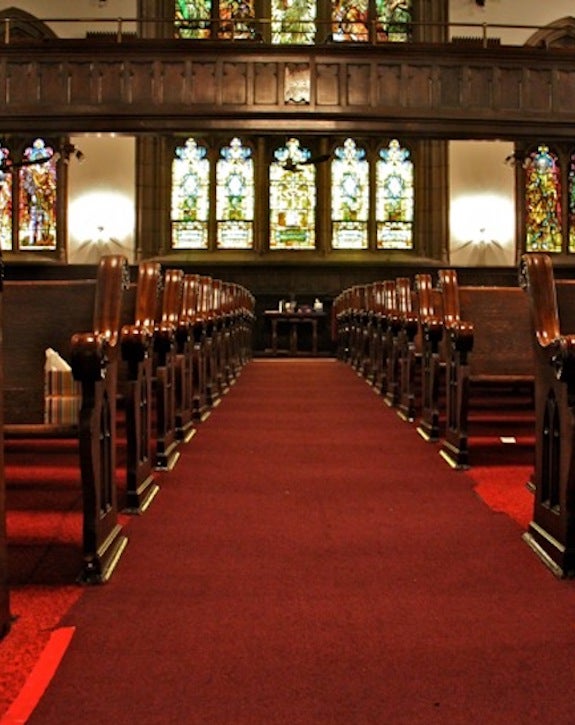
Building Blocks
Congregation: The Philadelphia Masjid
Community Partner: People’s Emergency Center
Address: 4700 Wyalusing Ave., Mill Creek
Design partner: HOK
Community Cornerstone
Congregation: Wharton-Wesley United Methodist Church
Community Partner: ACHIEVEability
Address: 5341 Catharine St., Cobbs Creek
Design partner: Brawer & Hauptman, Architects
Corridor Connections
Congregation: Zion Baptist Church
Community partner: Called to Serve CDC
Address: 3600 N. Broad St., Nicetown-Tioga
Design partner: Studio 6mm
WHYY is your source for fact-based, in-depth journalism and information. As a nonprofit organization, we rely on financial support from readers like you. Please give today.

